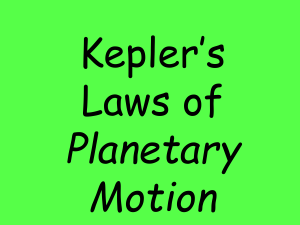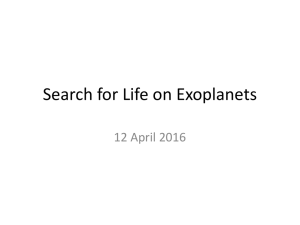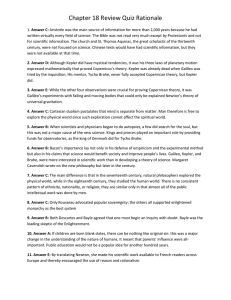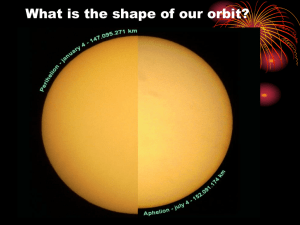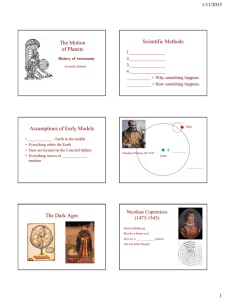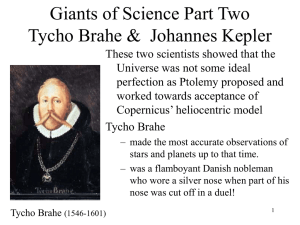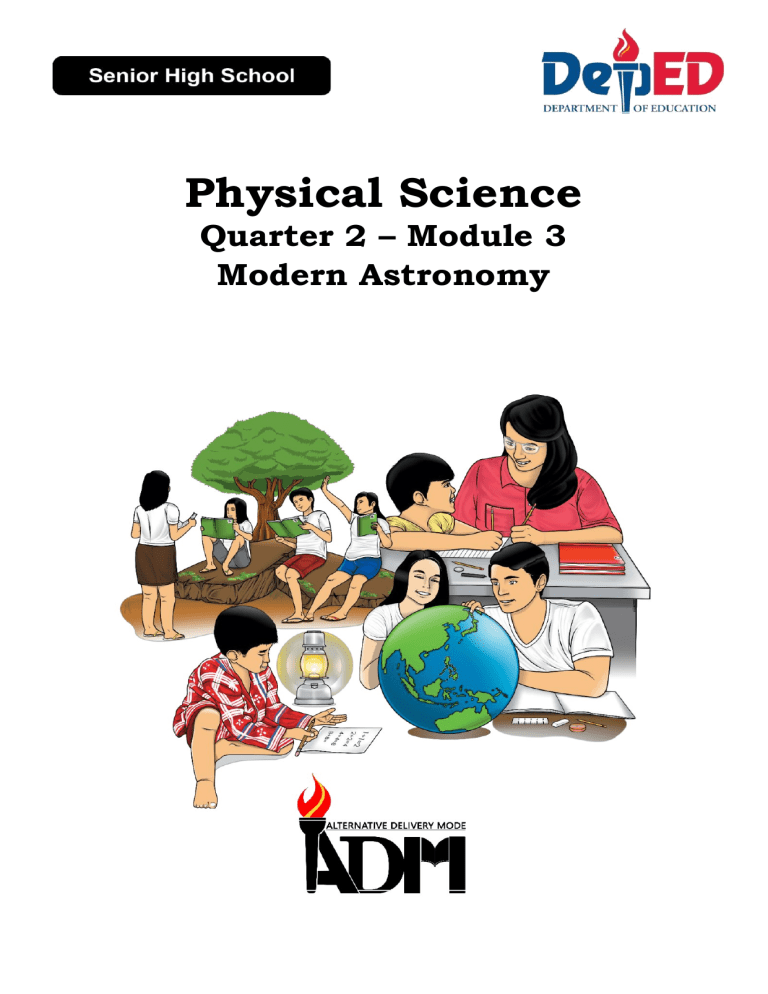
Physical Science Quarter 2 – Module 3 Modern Astronomy Physical Science Alternative Delivery Mode Quarter 2 – Module 3: Modern Astronomy First Edition 2020 Republic Act 8293, Section 176 states that “no copyright shall subsist in any work of the Government of the Philippines. However, prior approval of the government agency or office wherein the work is created shall be necessary for exploitation of such work for profit. Such agency or office may, among other things, impose as a condition the payment of royalties.” Borrowed materials (i.e., songs, stories, poems, pictures, photos, brand names, trademarks, etc.) included in this module are owned by their respective copyright holders. Every effort has been exerted to locate and seek permission to use these materials from their respective copyright owners. The publisher and authors do not represent nor claim ownership over them. Published by the Department of Education Secretary: Leonor Magtolis Briones Undersecretary: Diosdado M. San Antonio Development Team of the Module Writers: Jerwin A. Gutierrez and X-handi B. Fallarna Editors: Priscilla D. Domino, Felipa A. Morada Reviewers: Rogelio D. Canuel, Elmer C. Bobis, Felipa A. Morada Illustrator: John Albert Rico Layout Artist: Elsie R. Reyes Pamela A. Lalusin, Mary Grace L. Asa Management Team: Wilfredo E. Cabral, Regional Director Job S. Zape Jr., CLMD Chief Elaine T. Balaogan, Regional ADM Coordinator Homer N. Mendoza, Schools Division Superintendent Catherine V. Maranan, Assistant Schools Division Superintendent Lorna R. Medrano, CID Chief Edita T. Olan, EPS In-charge of LRMS Editha M. Malihan, EPS Printed in the Philippines by ________________________ Department of Education – RegionIV-A CALABARZON Office Address: Telefax: E-mail Address: Gate 2 Karangalan Village,Barangay San Isidro Cainta, Rizal 1800 02-8682-5773/8684-4914/8647-7487 region4a@deped.gov.ph/ict.calabarzon.gov.ph Physical Sciences Quarter 2 – Module 3 Modern Astronomy Introductory Message For the facilitator: Welcome to the Physical Science Grade 11 Alternative Delivery Mode (ADM) Modules on Modern Astronomy! This module was collaboratively designed, developed and reviewed by educators both from public and private institutions to assist you, the teacher or facilitator in helping the learners meet the standards set by the K to 12 Curriculum while overcoming their personal, social, and economic constraints in schooling. This learning resource hopes to engage the learners into guided and independent learning activities at their own pace and time. Furthermore, this also aims to help learners acquire the needed 21st century skills while taking into consideration their needs and circumstances. In addition to the material in the main text, you will also see this box in the body of the module: Notes to the Teacher This contains helpful tips or strategies that will help you in guiding the learners. As a facilitator you are expected to orient the learners on how to use this module. You also need to keep track of the learners' progress while allowing them to manage their own learning. Furthermore, you are expected to encourage and assist the learners as they do the tasks included in the module. ii For the learner: Welcome to the Physical Science 11 Alternative Delivery Mode (ADM) Module on Modern Astronomy! The hand is one of the most symbolized part of the human body. It is often used to depict skill, action and purpose. Through our hands we may learn, create and accomplish. Hence, the hand in this learning resource signifies that you as a learner is capable and empowered to successfully achieve the relevant competencies and skills at your own pace and time. Your academic success lies in your own hands! This module was designed to provide you with fun and meaningful opportunities for guided and independent learning at your own pace and time. You will be enabled to process the contents of the learning resource while being an active learner. This module has the following parts and corresponding icons: What I Need to Know This will give you an idea of the skills or competencies you are expected to learn in the module. What I Know This part includes an activity that aims to check what you already know about the lesson to take. If you get all the answers correct (100%), you may decide to skip this module. What’s In This is a brief drill or review to help you link the current lesson with the previous one. What’s New In this portion, the new lesson will be introduced to you in various ways such as a story, a song, a poem, a problem opener, an activity or a situation. What is It This section provides a brief discussion of the lesson. This aims to help you discover and understand new concepts and skills. What’s More This comprises activities for independent practice to solidify your understanding and skills of the topic. You may check the answers to the exercises using the Answer Key at the end of the module. What I Have Learned This includes questions or blank sentence/paragraph to be filled into process what you learned from the lesson. iii What I Can Do This section provides an activity which will help you transfer your new knowledge or skill into real life situations or concerns. Assessment This is a task which aims to evaluate your level of mastery in achieving the learning competency. Additional Activities In this portion, another activity will be given to you to enrich your knowledge or skill of the lesson learned. This also tends retention of learned concepts. Answer Key This contains answers to all activities in the module. At the end of this module you will also find: References This is a list of all developing this module. sources used in The following are some reminders in using this module: 1. Use the module with care. Do not put unnecessary mark/s on any part of the module. Use a separate sheet of paper in answering the exercises. 2. Don’t forget to answer What I Know before moving on to the other activities included in the module. 3. Read the instruction carefully before doing each task. 4. Observe honesty and integrity in doing the tasks and checking your answers. 5. Finish the task at hand before proceeding to the next. 6. Return this module to your teacher/facilitator once you are through with it. If you encounter any difficulty in answering the tasks in this module, do not hesitate to consult your teacher or facilitator. Always bear in mind that you are not alone. We hope that through this material, you will experience meaningful learning and gain deep understanding of the relevant competencies. You can do it! iv What I Need to Know This module was designed and written with you in mind. It is here to help you to explain how Tycho Brahe’s innovations and extensive collection of data in observational astronomy paved the way for Johannes Kepler’s discovery of his laws of planetary motion. The scope of this module permits it to be used in many different learning situations. The language used recognizes the diverse vocabulary level of students. The lessons are arranged to follow the standard sequence of the course. But the order in which you read them can be changed to correspond with the textbook you are now using. The module contains discussion about the five noted scientists who made important discoveries that gave rise to the birth of modern astronomy. After going through this module, you are expected to: 1. discuss the notable contributions of some of the notable astronomers of modern astronomy; 2. describe the relationship of Brahe and Kepler to the discovery of planetary motion; and 3. realize the importance of the laws of planetary motion. 1 What I Know Word Play! Directions: Use the pool of words in the box to complete the puzzle. Across 1. Earth does this around the sun once a year. 1. Dark region of the Sun due to lower temperature. 8. an obscuring of the light from one celestial body by the passage of another between it and the observer or between it and its source of illumination 12. are three scientific laws describing the motion of planets around the Sun, by Johannes Kepler 15. the perimeter of a circle or ellipse 2 Down 1. It is the shape of the Earth and some other planets. It is like a sphere squashed from the top so the diameter from pole to pole is less than the diameter from equator to equator. 3. An imaginary line through Earth. Down 4. A representation of the sun-Earth-moon system. 6. Discovered by Galileo to look at the moon, discover the four satellites of Jupiter, observe supernova, and discover sunspot. 7. Developed and formalized Galileo's concept of inertia. 9. A displacement or difference in the apparent position of an object viewed along two different lines of sight, and is measured by the angle or semiangle of inclination between those two lines. 10. Justified his Earth-centered model and explained retrograde motion through cycles and epicycles. 11. Earth's path in space. 13. His accurate measurements of Mars were his greatest contributions to astronomy. 14. Developed a heliocentric system wherein the orbits were elliptical rather than circular. This advanced the Sun-centered view. Pool of Words parallax circumference Planetary motion oblate spheroid eclipse model telescope Ptolemy axis revolve orbit Newton Kepler sunspots Tycho Brahe 3 Lesson 3 Modern Astronomy Throughout human history, scientists have struggled to understand what they see in the night sky. Famous astronomers — many of them great scientists who mastered many fields — explained the heavens with varying degrees of accuracy. Over the centuries, a geocentric view of the universe — with Earth at the center of everything — gave way to the proper understanding we have today of an expanding universe in which our galaxy is but one of billions. On this list are some of the most famous scientists from the early days of astronomy through the modern era, and a summary of some of their achievements. After 14 centuries since Ptolemy, five noted scientists made important discoveries that gave rise to the birth of modern astronomy. These were Nicolaus Copernicus, Tycho Brahe, Johannes Kepler, Galileo Galilei and Isaac Newton. 4 What’s In Matching Type. Directions: Match the five noted scientists in column A with their important discoveries in column B. Write the letter on the space provided before each number. Column A ________1. Nicolaus Copernicus ________2. Tycho Brahe ________3. Johannes Kepler ________4. Galileo Galilei ________5. Isaac Newton Column B A. He developed and formalized Galileo’s concept of inertia. He conceptualized the force of gravity and he was able to provide an explanation for the elliptical orbits. B. He was the greatest Italian scientist of the Renaissance. Due to the telescope, he was able to discover and observe important astronomical facts. C. Using his mentor’s data, he formulated the three laws of planetary motion: the law of Ellipse, Law of Equal Areas, and the Law of harmonies. D. He believed that only the sun and the moon revolved around the earth; the other planets revolved around the sun, which itself revolved around the earth. E. He was a student of Plato. For him, the earth is spherical in shape since it always casts a curved shadow when it eclipses the moon. F. He considered the sun as the stationary center of the universe. He classified earth as a planet just like Mercury, Venus, Mars, Jupiter, and Saturn. Notes to the Teacher Is science worth dying for? This may sound absurd and unlikely but for some scientist risking their lives for the truth is one of their greatest achievements. Students will analyze and discuss the implications of scientists defying cultural beliefs in older times and what science would be like today without the scientific analysis and discoveries of Tycho Brahe and Johannes Kepler. 5 What’s New Some Astronomical Terms for Students astronomical unit (AU) the unit of length defined as the average distance between Earth and the Sun; this distance is about 1.5 × 108 kilometers or 1.5 x 1011 metres eccentricity in an ellipse, the ratio of the distance between the foci to the major axis ellipse a closed curve for which the sum of the distances from any point on the ellipse to two points inside (called the foci) is always the same focus (plural: foci) one of two fixed points inside an ellipse from which the sum of the distances to any point on the ellipse is constant Kepler’s first law each planet moves around the Sun in an orbit that is an ellipse, with the Sun at one focus of the ellipse Kepler’s second law the straight line joining a planet and the Sun sweeps out equal areas in space in equal intervals of time Kepler’s third law the square of a planet’s orbital period is directly proportional to the cube of the semimajor axis of its orbit major axis the maximum diameter of an ellipse orbit the path of an object that is in revolution about another object or point orbital period (P) the time it takes an object to travel once around the Sun orbital speed the speed at which an object (usually a planet) orbits around the mass of another object; in the case of a planet, the speed at which each planet moves along its ellipse semimajor axis half of the major axis of a conic section, such as an ellipse 6 What is It Tycho Brahe Tycho Brahe was a Danish astronomer and nobleman who made accurate observations of the movement of celestial bodies in an observatory built for him by King Frederick II of Denmark in 1576. He was able to invent different astronomical instruments, with the help of his assistants, and made an extensive study of the solar system. He was able to determine the position of 777 fixed stars accurately. Johannes Kepler 7 When King Frederick II died, and the successor did not fully support Brahe’s work, he moved to Prague in 1599 where he was supported by Emperor Rudolf II and worked as an imperial mathematician. Emperor Rudolf II recommended Johannes Kepler to work for him as an assistant. Kepler was born to a poor German family and studied as a scholar at the University of Tübingen in 1589. Brahe and Kepler's Work Brahe and Kepler had an unsteady working relationship. Kepler was Brahe's assistant. However, Brahe mistrusted Kepler with his astronomical data in fear of being shadowed by his assistant. Brahe assigned to Kepler the interpretation of his observations of Mars, whose movement did not match Brahe’s calculations. Kepler was tasked to figure out what path Mars followed as it revolved around the Sun. It was believed by many scientists that Brahe gave this task to Kepler to keep him occupied and left Brahe to develop his laws of planetary motion. Kepler's Discoveries from Brahe's Data Kepler postulated that there must be a force from the Sun that moves the planets. He was able to conclude that this force would explain the orbit of Mars and the Earth, including all the other planets, moved fastest when it is nearest from the Sun and moved slowest when it is farthest from the Sun. Eventually, Brahe decided to give all his data to Kepler hoping that he would be able to prove his Tychonic system and put together new tables of astronomical data. This table was known as Rudolphine Tables, named after the Roman emperor and was useful in determining the positions of the planets for the past 1000 years and the future 1000 years. This table was the most accurate table that is known to the astronomical world. After Brahe died in 1601, Emperor Rudolf II assigned Kepler as the new imperial mathematician, and all of Brahe’s writings, instruments, and the Rudolphine tables were passed on to him. From Brahe’s data, Kepler was able to formulate his laws of planetary motion: the law of ellipses, the law of equal areas, and the law of harmonies. 8 Kepler’s Laws of Planetary Motion First Law - The Law of Ellipses When Kepler tried to figure out Mars’ orbit, it did not fit the then-famous theory that a planet follows a circular path. He then postulated that instead of a circular path, planets follow an oval or an ellipse orbit. This orbit matched his calculations and explained the “irregularities” in the movement of Mars. He was able to formulate his first law of planetary motion, the law of ellipses which describes that the actual path followed by the planets was elliptical, not circular, with the Sun at one focus of the ellipse. Second Law - The Law of Equal Areas The second law, which is the law of equal areas states that when an imaginary line is drawn from the center of the Sun to the center of a planet, the line will sweep out an equal area of space in equal time intervals. Planet P A B A B Elliptical orbit Figure 4: The figure shows the Kepler’s 2nd Law or The Law of Equal Areas 9 The law describes how fast a planet moves in its orbit. A planet moves fastest when it is nearest the Sun and slowest when it is farthest from the Sun, and still, the same area is swept out by the line in equal amounts of time. Third Law - The Law of Harmonies The law of harmonies, which is the third law, describes that the square of a planet’s orbital period (T2) is proportional to the cube of a planet’s average distance from the Sun (R3). It states that that the ratio of the squares of the periods of two planets is equal to the ratio of the cubes of the average distances of these two planets from the Sun or: where the subscript 1 indicates planet 1 and subscript 2 indicates planet 2. 50000 Neptune 10000 Uranus 1000 Saturn 100 Jupiter 10 Mars 1 Earth Venus Mercury 10 100 1000 10000 Square of Orbital Period (Yr2) Figure 4: The figure shows the Kepler’s 3rd Law or The Law of Harmonies 10 What’s More Our understanding of the elliptical motion of planets about the Sun spanned several years and included contributions from many scientists. Answer the questions below. Write your answers on a separate sheet of paper. Q1. Which scientist is credited with the collection of the data necessary to support the planet's elliptical motion? A1. _____________________________________ Q2. Which scientist is credited with the long and difficult task of analyzing the data? A2. _____________________________________ 3. Which scientist is credited with the accurate explanation of the data? A3. _____________________________________ 11 What I Have Learned Fill in the blanks with the correct answer. Write your answers on a separate sheet of paper. 1. ___________________ was a Danish astronomer and nobleman who made accurate observations of the movement of celestial bodies. 2. ___________________ was a German astronomer and mathematician who worked as an assistant to Brahe and formulated the three laws of planetary motion based on Brahe’s extensive astronomical data. 3. ____________________ states that planets follow an elliptical orbit. 4_____________________ states that when an imaginary line is drawn from the center of a planet to the center of the Sun, an equal amount of space is swept in equal amount of time. 5. __________________ states that the ratio of the squares of the period of two planets is equal to the ratio of the cubes of the planets’ average distance from the Sun.
